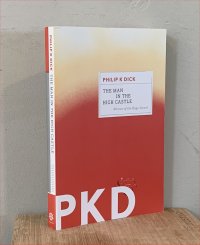I am going to begin posting relatively *brief* comments about books I’ve read lately, to keep up with what I’ve been reading. My extensive book summaries with comments take a long time to set up; by waiting to post anything about a book I’ve read until such a complete post is ready is a kind of “perfect is the enemy of good”. I can do shorter posts and keep up, and these shorter posts might actually be more useful to readers, than my lengthy summaries and comments have been.
But already I’m writing too much. Today’s post is about Philip K. Dick’s THE MAN IN THE HIGH CASTLE, published in 1962, winner of the Hugo Award, and a few years ago basis for a TV series… which I had not seen. I reread the novel a couple weeks ago.
Gist
This is a novel set in an “alternate history” in which events in our past played out differently, and explores the world as it might have become, in this case if Japan and Germany had won World War II, and taken over the United States between them. It wasn’t the first such novel, but is possibly the most famous.
Summary
There are four intermingled plot tracks:
- A shop owner in San Francisco, Robert Childan, is a dealer in fine American artifacts. He has a customer, high Japanese official Tagomi, who needs a very special gift for a visiting dignitary from Sweden, Mr. Baynes.
- Metal worker Frank Frink loses his job at a factory that deals with the manufacture of fake American artifacts, like Colt .45s. He then sets up his own shop making creative jewelry.
- Frank’s ex-wife Juliana Frink lives in Colorado, working as a judo instructor, where she meets a trucker named Joe, who moves in with her and then proposes a trip to visit the author, Abendsen, of the popular underground novel THE GRASSHOPPER LIES HEAVY, a “science fiction” novel in which Japan and Germany lost the war, and the US has created a social paradise. The final scenes (of the book we’re reading, not Grasshopper) describe Juliana’s meeting with Abendsen, and his admission of how he created the alternate world of his novel.
- Tagomi’s visit with Baynes is disrupted by news that the German Chancellor, Bormann, has died, and the eventual news about his replacement. Eventually an elaborate espionage plot by the Germans against the Japanese is revealed.
I have several general thoughts about this book, which I last read (before now) in 1988.
- First, especially in comparison to the three early PKD novels I reviewed for Black Gate in Sept. 2020 (here), I am deeply impressed by this novel, in a way I haven’t been impressed by rereading a novel since George R. Stewart’s EARTH ABIDES (reviewed in Jan 2020 here). It’s as if PKD stepped up another level, or two, from anything he’d done previously.
- Second, very little of this novel is explicitly SF (in contrast to those earlier novels). The initial attraction is the depiction of how Japan is running the US West, how Germany the east and south; how Germany has a final solution for Africa, how Japan is colonizing South America, how Germany is developing nuclear power and spaceflight, and is heading to Mars. The extrapolation of the world had they won WWII.
- The third fascination, perhaps the lasting one, which doesn’t appear right away in the book, is the “twist” that within this novel there is another novel that describes an “alternate history” that describes — though not quite exactly — our world, the world in which we are reading this book, close enough.
- A fourth point is that many of the characters rely on the “I Ching” to anticipate the future, and to help make everyday decisions.
- Comment: Like tea leaves or astrology, this is a system whose results invariably can be interpreted as something significant. Practitioners of the “oracle” are able to find deep meaning in every random throw. It’s an example of how humans find meaning in virtually everything, no matter how random; or perhaps it illustrates the human *need* to find meaning in random events. Or perhaps it’s simply a method for generating an arbitrary new perspective, something a person might not have thought of on their own.
- There is a theme about doubles (imitations) of artifacts, which parallels the revelation that some of the characters are not who they initially seem to be.. Who is who, what is what? This is a common theme among PKD’s novels and stories.
- And there is the complex espionage theme, about double agents trying to set up a German attack on Japan. (Is this the major theme of the TV adaptation? I don’t know, but I’ll check it out, at least through Wikipedia summaries of the show.)
- And there is the contemplative tone of the book, with several key characters engaging in deep introspection — Childan, Tagomi, Juliana.
Finally, this conclusion.
⦁ The resolution of this book is the revelation that the alternate book, THE GRASSHOPPER LIES HEAVY, was entirely driven, by the author Abendsen, of I Ching readings. In other words, his conception of our world was created out of randomness. (Did PKD use a similar scheme for this book, which seems so carefully contrived?) We might just as well have been living in PKD’s world, as the one we’re in. There’s no “reason” our world exists; it might as well be any other.
Quotes, from Mariner edition.
⦁ P114, about how an alternate history isn’t science fiction: “Oh no, No science in it. Nor set in future. Science fiction deals with future, in particular future where science has advanced over now. Book fits neither premise.”
⦁ p271: “Why that particular story and no other? What is there it can’t tell us directly, like it always has before?”






